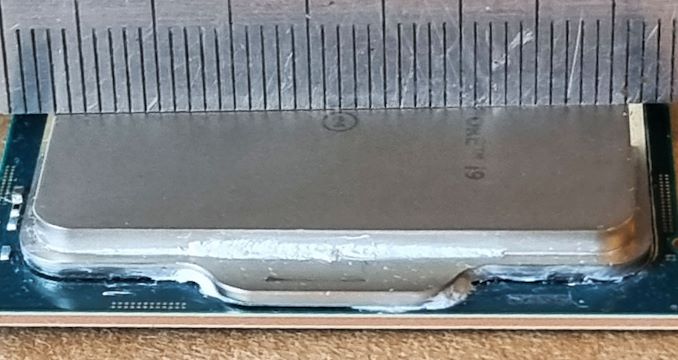The Intel Core i3-12300 Review: Quad-Core Alder Lake Shines
by Gavin Bonshor on March 3, 2022 8:30 AM ESTLGA1700: Reports of Bending Sockets
Since the launch of Intel's Alder Lake-based 12th generation Core processors, there have been several reports of high and abnormal temperatures, even at stock frequencies. The art in balancing out the integrated heat spreader (IHS) of a processor is one thing extreme overclockers have been working on for many years now. Typically called lapping, extreme overclockers finely sand down the IHS to make it a more flat and even surface. The aim is to reduce gaps by sanding out imperfections or curvatures. This is so that the cooling plate of the CPU cooler makes better contact with the IHS, and it has been known to reduce CPU thermals by a decent amount.

Our Core i9-12900K IHS is 'relatively' flat and even.
Fellow enthusiast Igor Wallossek published an article on his website, Igorlabs.de, which investigates potential issues with the ILM (independent loading mechanism), which keeps the processor firmly in place within the socket. Doing some investigations myself, our testbed Core i9-12900K which we've used the most doesn't seem to show any noticeable gaps or abnormal curvatures when used with a metal ruler. This, however, changes when we install the CPU into an LGA1700 socket or into one of the readily available Z690 motherboards.

The rear of the Intel LGA1700 socket with Core i9-12900K installed
There have been many reports that installing an Alder Lake processor into one of the cheaper Z690 or B660 models causes the CPU socket to bend and the IHS itself. We saw no bending before installing our Alder Lake processor into the socket of the GIGABYTE Z690 Aorus Master, which is a premium board priced around $470. Installing the Core i9-12900K into the socket and locking the ILM into place, we saw noticeable bending on the rear of the board, as our picture above illustrates.
The implications of this are two-fold. Firstly, from a cooling standpoint, it will and can lead to increased thermals due to the gaps this creates between the cold plate of the cooler and the IHS on the CPU. While thermal paste will generally fill some of the gaps, the problem is the nature of the gap and its size that the increased pressure the ILM creates. The second and perhaps the most fundamental part of this, it should NOT be happening.
Buildzoid 'rambles' about the LGA1700 washer mod, a potential fix?
While PCBs can be flexible, the nature of heat creating further expansion could lead to damaged sockets damaged processors and ultimately leave users with an expensive headache. There's also the potential to create permanent bends in the PCB area around the socket. This is not a good thing. It should be noted that LGA1700 motherboards either use ILM's manufacturers by Lotes or Foxconn, but it's reported that both ILMs are affected by this issue.
Fundamentally, there are a couple of potential workarounds to the issue, including a large, robust backplate. Still, on some of the AIO coolers, we have seen recently, these usually come with flimsy plastic backplates. Another potential fix is installing four washers to alleviate the issue. Both Igorlabs.de and Buildzoid have posted content detailing this, with Igor Wallossek doing some testing using washers of a different thickness to show variation.










140 Comments
View All Comments
TheinsanegamerN - Thursday, March 3, 2022 - link
You could read the review and look at the benchmarks, that may helpSunMaster - Thursday, March 3, 2022 - link
Todays games are nowhere near single threaded, even though there is a main thread. The reason alder lake does well is because it has several/many cores/threads clocked high performing well. both xbox and playstation have had multicore amds for a decade (since 2006 for PS, 2013 for xbox), which forced developers to focus on weaker threads rather than the old fashioned monolithic design.SunMaster - Thursday, March 3, 2022 - link
Can't edit my post it seems, but by multicore AMDS I meant 8 core.GeoffreyA - Tuesday, March 8, 2022 - link
I would say, ST is really the building block of multi-threading. Get that single brick strong, and the entire wall will be strong.mode_13h - Wednesday, March 9, 2022 - link
Ah, but it's not that simple. You need a good interconnect, cache, memory system, and clock/power-management.For instance, just look an Ampere Altra. Even though its single-thread performance is somewhat lacking, it shines at MT.
GeoffreyA - Wednesday, March 9, 2022 - link
Indeed, the mortar and bond style are just as important as the brick.mirancar - Thursday, March 3, 2022 - link
most games have some sort of single thread bottleneckalso web browser performance is highly affected by the single thread performance
this is what most people do 99% of time on their computers, almost nobody is "rendering"
more cores help up to a certain point, then it becomes useless. anything above 6C12T is usually completelly useless. single thread perf matters much more than 16 core 32 thread benchmark
Calin - Thursday, March 3, 2022 - link
Office applications. Legacy software. Interpreted code (as was the Visual Basic for Applications). Compilation (C or C++) of a single file.There are many places where "single-core" performance counts, as - if your typical operation lasts only a few seconds you might not really care to optimize (and going parallel might not be easy, and might not even be possible for some problems).
jcb2121 - Thursday, March 3, 2022 - link
ZwiftWereweeb - Thursday, March 3, 2022 - link
Virtually every application. Google "Amdahl's Law".